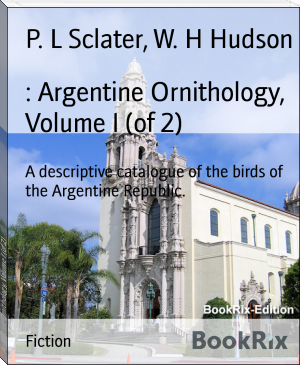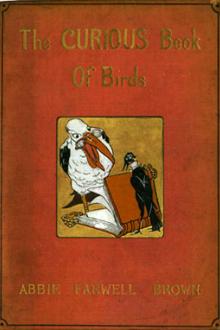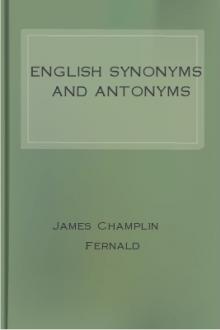: Argentine Ornithology, Volume I (of 2), P. L Sclater, W. H Hudson [best authors to read txt] 📗

- Author: P. L Sclater, W. H Hudson
Book online «: Argentine Ornithology, Volume I (of 2), P. L Sclater, W. H Hudson [best authors to read txt] 📗». Author P. L Sclater, W. H Hudson
the centre of a large bush or low tree. The eggs are four, pale blue in
colour, and thickly spotted with brown.
3. TURDUS MAGELLANICUS, King. ((MAGELLANIC THRUSH.))
+Turdus magellanicus+, _Seebohm, Cat. B._ v. p. 223, pl. xiv. +Turdus
falklandicus+, _Scl. et Salv. Nomencl._ p. 2; _Hudson, P. Z. S._
1872, p. 548 (Rio Negro); _Döring, Exp. al Rio Negro, Zool._ p.
36 (R. Colorado and R. Negro).
_Description._--Head, wings, and tail brownish black; the remaining
portions of upper surface brownish olive; under surface pale
rufous, obscure on the breast; throat white, striped with black;
bill and feet dull yellow: total length 10·5 inches, wing 7·5, tail
4·0. _Female_ similar.
_Hab._ Patagonia and Chili.
This Thrush, which I met with on the Rio Negro of Patagonia, so closely
approximates to _T. rufiventris_ in colour, language, and habits, that
the casual observer finds it difficult to distinguish one from the
other. Its nest and eggs are also precisely like those of its northern
representative. The song is, however, much poorer, and reminds one of
the first attempts of a young bird. That a member of so melodious a
family should have so inferior a song I attribute to the fact that
Thrushes (unlike the songsters of other genera) sing only in the
warm season and when the air is calm. In the southern portion of the
South-American continent violent winds prevail in summer, so that this
southern Thrush sings perhaps less frequently than any other song-bird,
and appears to be losing the faculty of song altogether.
4. TURDUS FUSCATER, d'Orb. et Lafr. ((ARGENTINE BLACKBIRD.))
+Turdus fuscater+, _Scl. et Salv. Nomencl._ p. 2; _White, P. Z. S._
1882, p. 593 (Catamarca); _Burm. La-Plata Reise_, ii. p. 474
(Mendoza, Cordova, and Tucuman). +Merula fuscatra+, _Seebohm,
Cat. B._ v. p. 243.
_Description._--Uniform brownish black; bill and feet yellow: total
length 11·5 inches, wing 5·3, tail 4·5. _Female_ similar.
_Hab._ Bolivia and Northern La Plata.
"I have noticed this bird in the provinces of Mendoza, San Juan, San
Luis, Cordova, and Catamarca, where it is much esteemed as a cage-bird
on account of its beautiful whistle. In Mendoza it goes by the name of
'Zorsal,' in Catamarca and Cordova by that of 'Merlo,' and in Andalgala
(Catamarca province) 'Chocoyno.'"--_White, l. s. c._
"Very common at Mendoza, Cordova, and Tucuman, and met with among the
shady trees of the promenades: has a better song than our Blackbird,
which is heard at a distance, especially in the evening. Called
'Crispin' in Tucuman."--_Burm. l. s. c._
5. TURDUS NIGRICEPS, Cab. ( (BLACK-HEADED THRUSH.))
+Turdus nigriceps+, _Cab. J. f. O._ 1878, p. 195.
_Description._--Above slaty grey, head black; below paler, chin
white, striped with black; middle of belly and crissum white; bill
and feet pale yellow: total length 7·6 inches, wing 4·4, tail 3·5.
_Female_ olive-brown, paler below, chin pale ochraceous; middle of
belly and crissum white; bill brown, feet yellowish.
_Hab._ Peru, Bolivia, and Northern La Plata.
Met with by Dr. A. Döring and Herr Schulz on the Sierra of Cordova.
6. MIMUS MODULATOR, Gould. ((CALANDRIA MOCKING-BIRD.))
+Mimus modulator+, _Sharpe, Cat. B._ vi. p. 347. +Mimus calandria+,
_Burm. La-Plata Reise_, ii. p. 475; _Scl. et Salv. Nomencl._ p.
3; _Hudson, P. Z. S._ 1870, p. 89 (Buenos Ayres); _Durnford,
Ibis_, 1877, p. 167 (Buenos Ayres); _White, P. Z. S._ 1883, p. 37
(Cordova); _Barrows, Bull. Nutt. Orn. Cl._ viii. p. 85
(Concepcion).
_Description._--Above dark grey, faintly mottled with pale grey;
rump tinged with brown; wings nearly black, the feathers edged with
brownish white; tail black, the feathers, except the two middle
ones, broadly tipped with white; under surface dirty white; bill and
legs black; eye olive-green: total length 11·0 inches, wing 4·5,
tail 4·9. _Female_ similar.
_Hab._ Paraguay, Uruguay, and Argentine Republic.
Azara has not failed to remark that it would be well to find a more
appropriate name for this species, which was absurdly called "Calandria"
(_i. e._ Sky-Lark) by the early colonists of the Plata. Use is, however,
too strong to be easily set aside, and the name is now familiar to
everyone in the Argentine Province. Moreover, by a curious irony of
fate, the Spanish naturalist himself, by employing this unsuitable name
in his 'Apuntamientos,' even while protesting against it, has been the
cause of its introduction into scientific nomenclature.
It would be impossible to improve on the account Azara gives of the
bird's appearance and manners. The prevailing colour of the plumage is
grey, the irides are deep green, the beak black, slender, and curved.
The tail is long, jerked and elevated when the bird is at rest, spread
open and depressed in flight. The Calandria's movements are measured
and dignified, its flight low and never extends far, the bird usually
passing from one tree to another in a long graceful curve. It goes alone
or with its mate only; feeds chiefly on the ground; does not penetrate
into deep forests, nor is it seen on the treeless plains. It frequents
the borders of woods and open grounds abounding in isolated shrubs and
trees; is fond of coming about houses, and invariably perches itself
on the most conspicuous places. It sings chiefly in spring, and its
really wonderful vocal powers have made it one of our best-known and
most-admired songsters. To sing it usually places itself on the summit
of a bush or tree, and occasionally, as if carried away by excitement,
it darts upwards three or four yards into the air, and then drops back
on to its perch. So varied are its notes, and so frequently suggestive
of the language of other species, that the listener finds himself
continually asking whether the Calandria is really an original singer or
merely a cunning plagiarist, able to steal scraps of fifty different
melodies and to blend them in some sort into one complete composition.
As a whole the song is in character utterly unlike that of any other
bird (birds of the _Mimus_ genus, of course, excepted), for the same
notes are never repeated twice in the same order; and though the
Calandria has many favourite notes, he is able to vary every one of
them a hundred ways. Sometimes the whole song seems to be made up of
imitations of other singers, with slight variations--and not of singers
only, for now there will be clear flute-like notes, only to be succeeded
by others reedy and querulous as the hunger-calls of a young Finch; then
there will be pretty flourishes or Thrush-like phrases, and afterwards
screams, as of a frightened Swallow hurrying through the sky to announce
the approach of a Falcon; or perhaps piteous outcries, as of a chicken
in the clutches of a Kite.
Nevertheless Azara says truly that the Calandria does not mock or mimic
the songs of other birds; for though the style and intonation of a score
of different singers, chatterers, and screamers are reproduced by him,
one can never catch a song, or even a portion of a song, of which he is
able to say that it is absolutely like that of any other species. This
much, however, can be said of the Calandria: he has a passion for
endless variety in singing, a capacity for varying his tones to almost
any extent, and a facility for catching the notes of other birds, which,
in the Virginian Mocking-bird of North, and in the White-banded
Mocking-bird of South America, has been developed into that marvellous
faculty these two species possess of faithfully imitating the songs of
all other birds. The two species I have just named, while mockers of
the songs of other birds, also retain their own original music--their
"natural song," as an American ornithologist calls it.
The Calandria makes its nest in the middle of a large bush or low
thorn-tree standing by itself; it is deep, like the nest of a Thrush in
form, built of sticks, thorns, and grass, and lined with thistle-down or
some other soft material. The eggs are four or five, pale blue, and
thickly marked with reddish-brown spots.
When the nest is approached the parent birds demonstrate their anxiety
by uttering loud harsh angry notes.
It is generally believed that the Calandria will not live in captivity.
I have, however, seen a few individuals in cages, but they never sang.
7. MIMUS PATACHONICUS (d'Orb. et Lafr.). ((PATAGONIAN MOCKING-BIRD.))
+Mimus patachonicus+, _Scl. et Salv. Nomencl._ p. 3; _Hudson, P. Z.
S._ 1872, p. 538 (Rio Negro); _Durnford, Ibis_, 1877, p. 31
(Chupat); _Döring, Exp. al Rio Negro, Zool._ p. 36 (R. Colorado);
_Sharpe, Cat. B._ vi. p. 352. +Mimus thenca+, _Burm. La-Plata
Reise_, ii. p. 475 (Mendoza)?
_Description._--Above and beneath grey, paler on the under surface,
and tinged with rufous on the belly; throat and mark over the eye
white; wings black, the outer webs of the





Comments (0)